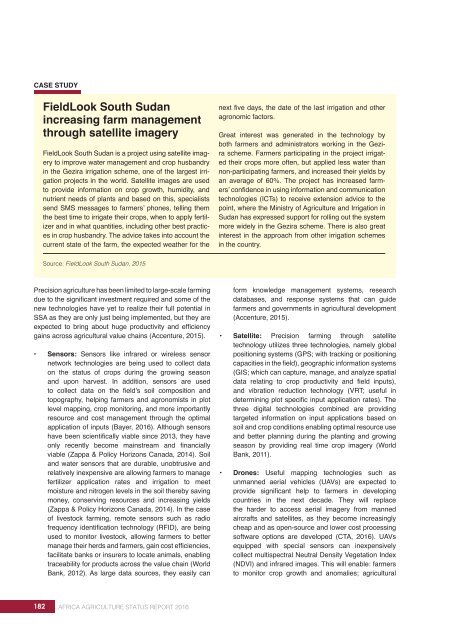AFRICA AGRICULTURE STATUS REPORT 2016
AASR-report_2016-1
AASR-report_2016-1
Create successful ePaper yourself
Turn your PDF publications into a flip-book with our unique Google optimized e-Paper software.
CASE STUDY<br />
FieldLook South Sudan<br />
increasing farm management<br />
through satellite imagery<br />
FieldLook South Sudan is a project using satellite imagery<br />
to improve water management and crop husbandry<br />
in the Gezira irrigation scheme, one of the largest irrigation<br />
projects in the world. Satellite images are used<br />
to provide information on crop growth, humidity, and<br />
nutrient needs of plants and based on this, specialists<br />
send SMS messages to farmers’ phones, telling them<br />
the best time to irrigate their crops, when to apply fertilizer<br />
and in what quantities, including other best practices<br />
in crop husbandry. The advice takes into account the<br />
current state of the farm, the expected weather for the<br />
next five days, the date of the last irrigation and other<br />
agronomic factors.<br />
Great interest was generated in the technology by<br />
both farmers and administrators working in the Gezira<br />
scheme. Farmers participating in the project irrigated<br />
their crops more often, but applied less water than<br />
non-participating farmers, and increased their yields by<br />
an average of 60%. The project has increased farmers’<br />
confidence in using information and communication<br />
technologies (ICTs) to receive extension advice to the<br />
point, where the Ministry of Agriculture and Irrigation in<br />
Sudan has expressed support for rolling out the system<br />
more widely in the Gezira scheme. There is also great<br />
interest in the approach from other irrigation schemes<br />
in the country.<br />
Source: FieldLook South Sudan, 2015<br />
Precision agriculture has been limited to large-scale farming<br />
due to the significant investment required and some of the<br />
new technologies have yet to realize their full potential in<br />
SSA as they are only just being implemented, but they are<br />
expected to bring about huge productivity and efficiency<br />
gains across agricultural value chains (Accenture, 2015).<br />
• Sensors: Sensors like infrared or wireless sensor<br />
network technologies are being used to collect data<br />
on the status of crops during the growing season<br />
and upon harvest. In addition, sensors are used<br />
to collect data on the field’s soil composition and<br />
topography, helping farmers and agronomists in plot<br />
level mapping, crop monitoring, and more importantly<br />
resource and cost management through the optimal<br />
application of inputs (Bayer, <strong>2016</strong>). Although sensors<br />
have been scientifically viable since 2013, they have<br />
only recently become mainstream and financially<br />
viable (Zappa & Policy Horizons Canada, 2014). Soil<br />
and water sensors that are durable, unobtrusive and<br />
relatively inexpensive are allowing farmers to manage<br />
fertilizer application rates and irrigation to meet<br />
moisture and nitrogen levels in the soil thereby saving<br />
money, conserving resources and increasing yields<br />
(Zappa & Policy Horizons Canada, 2014). In the case<br />
of livestock farming, remote sensors such as radio<br />
frequency identification technology (RFID), are being<br />
used to monitor livestock, allowing farmers to better<br />
manage their herds and farmers, gain cost efficiencies,<br />
facilitate banks or insurers to locate animals, enabling<br />
traceability for products across the value chain (World<br />
Bank, 2012). As large data sources, they easily can<br />
form knowledge management systems, research<br />
databases, and response systems that can guide<br />
farmers and governments in agricultural development<br />
(Accenture, 2015).<br />
• Satellite: Precision farming through satellite<br />
technology utilizes three technologies, namely global<br />
positioning systems (GPS; with tracking or positioning<br />
capacities in the field), geographic information systems<br />
(GIS; which can capture, manage, and analyze spatial<br />
data relating to crop productivity and field inputs),<br />
and vibration reduction technology (VRT; useful in<br />
determining plot specific input application rates). The<br />
three digital technologies combined are providing<br />
targeted information on input applications based on<br />
soil and crop conditions enabling optimal resource use<br />
and better planning during the planting and growing<br />
season by providing real time crop imagery (World<br />
Bank, 2011).<br />
• Drones: Useful mapping technologies such as<br />
unmanned aerial vehicles (UAVs) are expected to<br />
provide significant help to farmers in developing<br />
countries in the next decade. They will replace<br />
the harder to access aerial imagery from manned<br />
aircrafts and satellites, as they become increasingly<br />
cheap and as open-source and lower cost processing<br />
software options are developed (CTA, <strong>2016</strong>). UAVs<br />
equipped with special sensors can inexpensively<br />
collect multispectral Neutral Density Vegetation Index<br />
(NDVI) and infrared images. This will enable: farmers<br />
to monitor crop growth and anomalies; agricultural<br />
182 <strong>AFRICA</strong> <strong>AGRICULTURE</strong> <strong>STATUS</strong> <strong>REPORT</strong> <strong>2016</strong>


